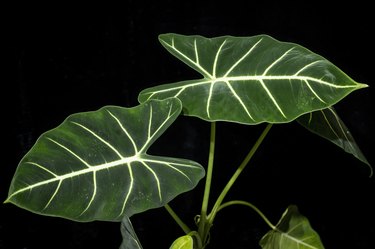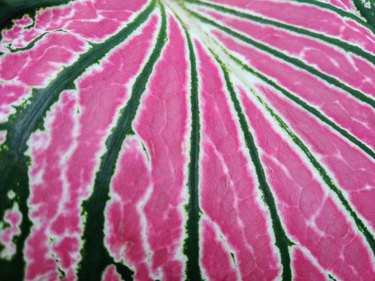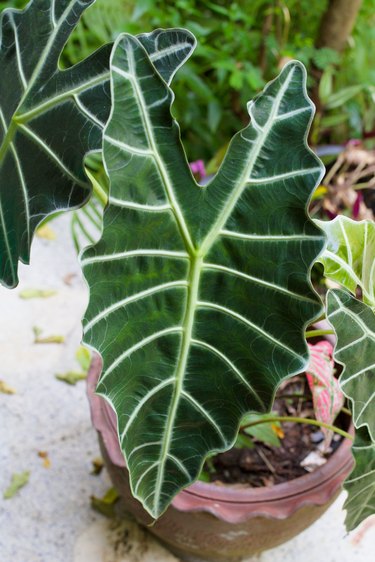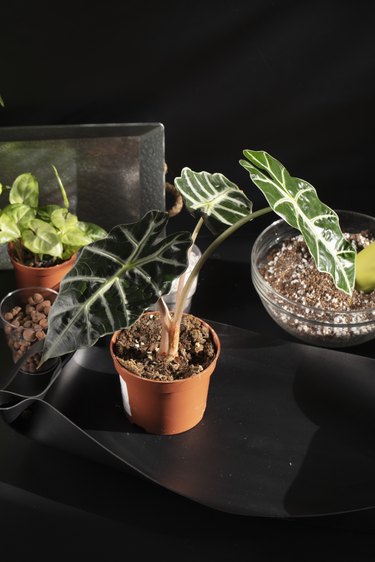
It's easy to fall for a houseplant with a name like "elephant ear." Yes, this is a foliage plant and not one grown for flowers, but when you get a look at the drama of its gigantic, heart-shaped leaves with bright, contrasting veins, you are very likely to fall under its spell.
I did! Someone once gifted me the dried corm — the type of bulb from which Alocasia elephant ear plants grow — and it absolutely wowed me. Easy to grow and utterly magical, Alocasia plants add a tropical elegance to your home or garden.
Video of the Day
Video of the Day

Alocasia Highlights
Easy care? Yes!
Light and location: Near a window with bright, indirect light.
Watering: Water regularly so that the soil never dries out.
Growth rate: Fast-growing.
Flowers: Rarely flowers indoors.
Pet-safe? No! Toxic to dogs, cats, and humans.
All About Elephant Ears
Elephant ear plants are fast-growing bulb plants that rapidly evolve from dry corms to lush, tropical beauties in a single growing season. The heart-shaped leaves can be as big as the elephant ears from which they get their common name, growing up to 3 feet long. Stems can grow to 7 feet.
Elephant ear foliage comes in a wide variety of colors, from shades of green to near black, with dramatically contrasting veins or other bold color designs. Most are found in the Alocasia genus and are native to tropical areas of South and Central America, Asia, Africa, and Australia. The plants are hardy outdoors in USDA hardiness zones 9 to 12, but they thrive as houseplants in ordinary household temperatures.
These are easy plants to grow but don't make the same mistake I did and assume that all "tropical" plants like direct sun. I can tell you from experience that your plants can go from drop-dead gorgeous to just plain dead in a very short time. Instead, follow the three essential care rules:
- Keep your plant in indirect or dappled sunlight.
- Use humus-rich soil.
- Keep the soil moist.

Care and Feeding of an Elephant Ear Plant
When I bought a stunning elephant ear potted houseplant at the San Francisco Botanical Garden plant sale, I was excited but nervous. How could I keep the plant as gorgeous as it was at that moment?
The gardener at the botanical garden told me that I would be just fine if I simply met their basic cultural requirements. They require indirect sun, organically rich soil, and enough water to keep the soil moist. That's it!
Let's take a closer look at each of these requirements.

Best Location for the Elephant Ear Plant
In the wild, elephant ear plants grow in the filtered sun of a tropical forest. That means they are not fans of hot, direct sun because their leaves crisp and wilt. Outside, they prefer dappled light, and as indoor houseplants, they do best when placed several feet back from a sunny window. Bright, indirect light is key to elephant ear happiness.
Potting Soil for the Elephant Ear Plant
In the wild, elephant ear plants grow in the organically rich soil of a forest floor. It's important to mimic that for your houseplant. Either buy quality potting soil and add aged organic compost or buy quality potting soil that already incorporates organic compost. The organic material will hold on to moisture, but the soil should also drain well.
Temperature & Humidity for the Elephant Ear Plant
Average household temperatures are fine for your Alocasia plant. If you want to offer it a bit more warmth, you can place your plant outdoors during the daytime in summer, but bring it indoors every night when temperatures dip.
Elephant ear plants are rain forest natives and love humidity. No, this really isn't optional. You can increase the plant's humidity using any of the standard means, like setting the plant on a pebble saucer, misting the foliage regularly, or getting a small humidifier and placing it near the plant.

Watering the Elephant Ear Plant
Sufficient water is essential for elephant ear plants. The plant's native environment is damp or wet soil, and that is what they prefer. Water the container plants regularly and thoroughly, avoiding contact with the leaves.
Here's a good rule of thumb: If the top inch of soil feels dry, it is time to water. You may have to water every other day or even every day during the growing season. Never let the soil dry out.
Fertilizer for the Elephant Ear Plant
Apply a slow-release fertilizer about once a month during the growing season. Elephant ears like the extra nutrients.
Propagating an Elephant Ear Plant
Seeds may be the first thing you think of when it comes to propagating elephant ears. Elephant ear landscape plants do produce flowers and seeds, but it is pretty rare for indoor elephant ear plants to blossom. In addition, many of the popular varieties of elephant ears are cultivars, which means a seedling won't look like the parent.
Don't even try to root an elephant ear cutting. These are bulb plants that grow from a type of bulb called a corm. If you cut off a stem or leaf and place it in water, it will not produce roots.
To propagate the plant, divide the tubers that expand as the plant ages. When the growing season is over, dig up the corm and cut it into clumps, making sure that each separate section has at least one growth node. Allow the cut edges to dry out and then wrap each division in paper and store in a cool area until the next spring.

Elephant Ear Plant Varieties
While the common name "elephant ear" is used for large-leafed plants in both the Alocasia and the Colocasia genera, you'll be happier if you hold out for the former. Plants in the Alocasia genus are upright plants that make excellent houseplants, doing well indoors in indirect light.
When you are selecting a cultivar, keep one eye on the mature height. Some plants grow very tall indeed. Here are a few shorter cultivars:
- Kris plant (Alocasia sanderiana) is a popular houseplant with striking foliage: dark, shiny leaves with deep lobes and bright white veins. Naive to the Philippines, it likes a humid environment. It matures to 2 feet tall and wide.
- Black velvet (Alocasia reginula 'Black Velvet')
is ideal for smaller areas. It offers fuzzy gray-green leaves with contrasting white veins. It grows more slowly than other varieties and stays under 1.5 feet tall.
- Alocasia dragon scale (Alocasia baginda) went from rare to widely available, so search it out. Its pale green leaves are shaped like hearts and offer darkly splendid veining. It tops out at 2 feet tall and wide.
- Alocasia pink dragon (Alocasia lowii 'Morocco') has green foliage with pink stems and grows to 4 feet tall. It needs high humidity and lots of fertilizer.
- Frydek (Alocasia micholitziana 'Frydek') adds class to any room, growing to 3 feet in both directions. Its thick white veins look like they were painted on the velvety green leaves.

Repotting the Elephant Ear
Elephant ear tubers grow bigger each year, resulting in more stems and foliage during the growing season. If you don't divide the corms, you may need to switch your elephant ear corm to a different pot. Select a heavy pot a few inches larger than the current pot, add a mix of compost and potting soil, and then transfer the corm from the old pot to the new one. Plant the corm about 6 inches under the soil.
You may be happier, however, if you divide the corm into a number of pieces. Plant each one in a heavy pot and you will see faster, fuller growth.

Common Elephant Ear Pests
Elephant ears can attract the common insect pests that plague other plants, including aphids, whiteflies, and spider mites. Keep these pests in check by inspecting the foliage regularly.
Act immediately if you spot pests. Many can simply be rinsed off the plant, while bigger infestations can require the use of neem or horticultural oils.
FAQ
What is a good indoor temperature for an elephant ear plant?
Ordinary household temperatures are fine if they are between 60 and 70°F.
Why is this plant called "elephant ear"?
Many believe that the plant's huge leaves are the same size and shape as the ears of an elephant.
Will fertilizer help my plant?
Fertilizer may well help your elephant ear to grow faster.